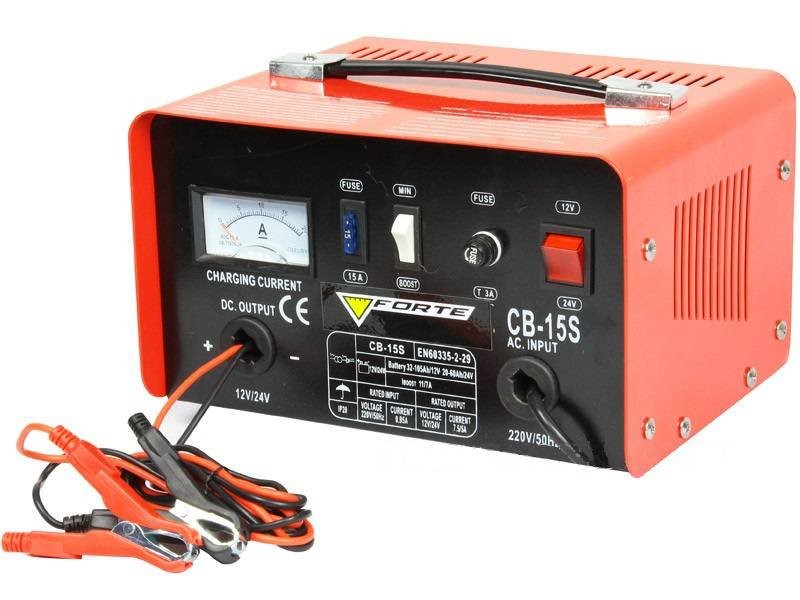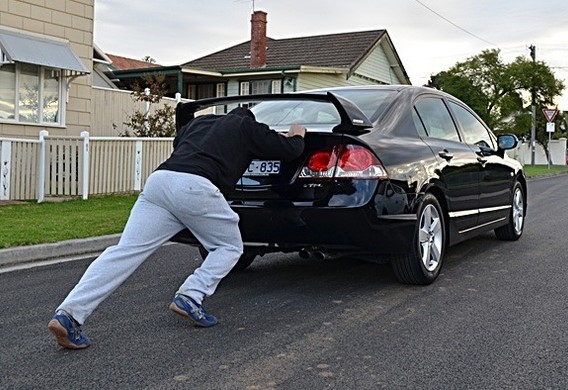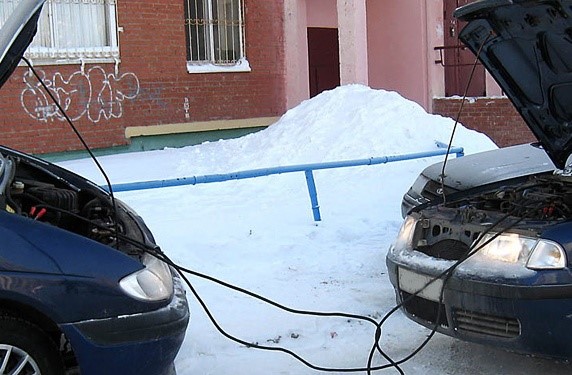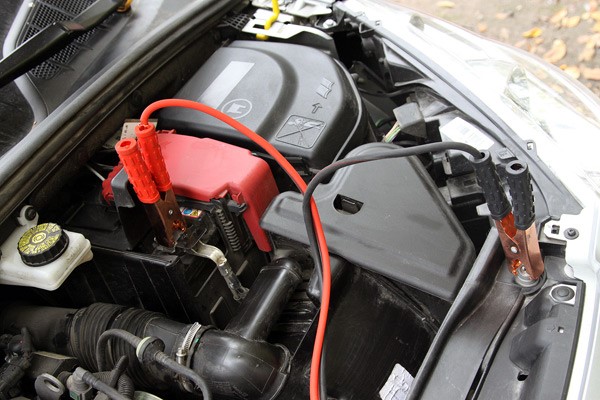Discharged accumulator battery gives car owners a lot of trouble - often situations arise when the battery in the car runs out and it is impossible to start the engine with the ignition key.
In such cases, you have to light a car from another car, the drivers also use other ways to start the engine. The reasons why the battery has run out may be the following:
- the included dimensions or a radio tape recorder were left in the car at night;
- in the cold, the battery has lost its capacity;
- the battery is old and needs to be replaced.
The most correct decision in this case is to buy new battery, but for some reason it is not always possible to make a purchase. What other way out of this situation?
Methods for starting the engine with a discharged battery
In order to start the engine, motorists use the following options:
- recharge the battery using a special charger;
- start the machine from the "pusher";
- start the engine by towing another car;
- use the method of lighting a car from another car.
All of these methods have their pros and cons, but they cannot be used in every situation.
As a rule, a charger helps car owners well in the event that the battery is dead. But this method has its drawbacks:
- charging takes a long time (from several hours to a day), and if you need to go urgently, then this is not a way out;
- if the battery is old, and the plates in the banks are crumbling, then it is no longer charged;
- "Charger" needs to be bought.
In order to start the car from the pusher, several people are needed who could push the car from behind. Here, too, a lot depends on the situation:
- there is not always the right number of people;
- a car with an automatic gearbox from the pusher starts at your own peril and risk.
If the machine is equipped with an automatic transmission, it is highly discouraged to use the pusher method. Perhaps the engine will start, but the risk of automatic transmission breakdown in this case is very high.
You can start the car by towing, but there are also some difficulties here:
- a towing cable is required, but it is not always available;
- for towing, you need to find a driver and a car on the move;
- it is also forbidden to tow cars with automatic transmission gear.
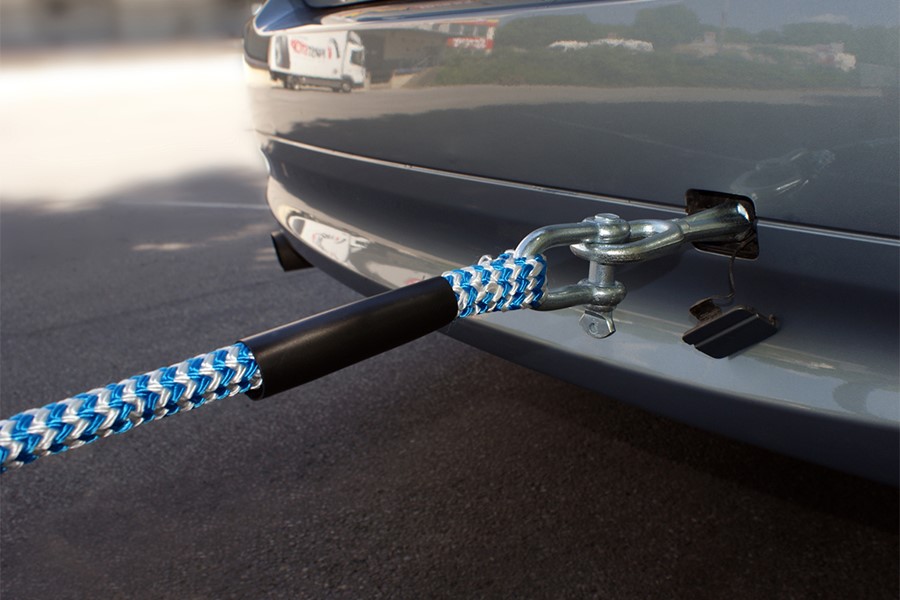 Lighting method
Lighting method
Lighting a car from another car is the easiest and safest of all, here the advantage is at least that you can start the engine in this way on cars with any transmission. In order to start the engine from another car, you will need:
- the car itself with good battery and a working engine;
- special wires for lighting.
The wires must meet certain requirements, and if the conductors are too thin, then the wires will heat up, and the power of another battery will not be enough to start the motor. All the ends of the wires have special crocodile clips, with the help of which two batteries could be connected. The contact between the conductive core and the terminal clamp must be reliable.
Safe lighting rules
You can "light a cigarette" from almost any working vehicle, but before starting such an operation, you must follow some rules:
- cars (one of them with a dead battery, the second is a donor) must be placed next to each other so that the length of the lighting wires is enough from one battery to another;
- both engines must be turned off, and the ignition off on both cars;
- it is necessary to turn off all electrical appliances on both vehicles.
Only then can you connect the wires between the batteries. Why is it so important to fulfill all these conditions and act only according to this scheme?
If you do not follow the elementary rules, then when you connect the donor car battery to a dead battery and when the ignition is on, a voltage drop may occur on the car being started. As a result, electronic systems can fail, for example, the engine control unit on any of the cars.
Another rule is that you can only light it in an open space; you cannot start in this way in a garage or in another indoors.
Factory lighting wires have different colors of insulation:
- red - for connecting to the positive terminals;
- black - for connection to ground.
Before lighting a car from another car, it is necessary to connect the positive terminals of the batteries with a red wire, the mass terminals of the battery are connected with a black lead. Moreover, first of all, the plus is connected, and only after that the mass is established. In no case should the polarity be confused here, otherwise some electronic systems may fail. You can connect the mass wire according to a different scheme:
- we connect one end of it with the "minus" of the battery of the donor car;
- the other end of the wire is fixed on any part of the body with the unpainted metal of the starting car or on the metal part of the engine itself.
It is necessary to try to "throw" the mass as far as possible from the fuel line - if, when starting the engine, the wires suddenly sparkle, a fire is possible.
- start the engine of the donor car and let it run for at least 5 minutes. It is also recommended to add revolutions to two to three thousand, due to this, the battery of the engine being started is somewhat recharged;
- then we turn off the donor's engine and try to start the car with a dead battery.
If the car with a bad battery starts up, then everything is fine, if the starter turns poorly and the engine does not pick up, you can once again try to recharge the dead battery with the donor car's battery.
If, nevertheless, the car with a dead battery does not start, then you can connect the lighting wire directly to the battery negative wire of the car you want to start. Thus, the energy of the donor car battery will not be spent on charging the dead battery, all of it will go to the starter. And if you light it up correctly, with such a connection of wires, the car should start in any case. The car does not start only if there are some malfunctions in the engine or starter.
There are many cases when motorists start a car with a dead battery using lighting wires with the donor car's engine running. Moreover, in order for the car with a dead battery to start up faster, the donor's engine is also supplied with gas.
Here everything turns out like in a lottery - everything can go smoothly, and there will be no problems. But it can be differently:
- the engine control unit of the donor car will fail;
- a diode bridge or a voltage regulator on the generator will fly.
When the donor engine is running, during lighting, a voltage drop occurs and the load on the generator increases. The more the battery of the started car is planted and the larger the volume of its engine, the more difficult it is to start and the more energy is wasted.
From this we can conclude that if the donor's engine is low-power, then it is more likely that the electrical equipment or the generator of this car will fail. That is, if you light a VAZ 2114 with a KAMAZ, then the probability of a breakdown of the KAMAZ generator is small. In the case of the opposite, most likely, on a VAZ 2114 car, any electronics with a high degree of probability can be damaged.
- If the car is started by lighting, the wires should be disconnected in the following order:
- "Minus" from the body of the car that was started;
- mass wire from the donor terminal;
- "Plus" from a car with a dead battery;
- positive lead from the donor car battery.
- A small car does not need a cigarette lighter for some more solid car, for example, an SUV or a truck.
- The batteries must have the same voltage, for example, both batteries are rated for 12 volts.
- The lighting wires must be thick and secure, with good grip on the ends.
Surely many of you have come across a situation when at one point it turned out that the alarm in the car does not work, and when the ignition key is turned, the starter just makes a click, after which all the dashboard indicators go out. can happen for various reasons, but most often it happens due to the power source left on, which can be a radio or lighting fixtures. If you don't have a charger on hand, there is an old proven way to start the engine for that case. To do this, you will need the help of another car and wires for lighting (crocodiles). So, below we will tell you how to light a dead battery from another car.
We light the car
First of all, you should make sure that the problem is really shrunken. If the starter does not rotate, but at the same time all electrical appliances, including the radio, headlights and others, are working normally, then this is not a matter of discharging the battery. And if the car behaves as described above, you can safely proceed to lighting the car.
First of all, you need to find another car with a charged battery, for example, ask for help from a neighbor in the garage. Then the cars should be positioned so that the wires for lighting can reach from one battery to another, while it is important that the cars do not touch each other. Both must be put on the handbrake and the engine off. Then you should turn off the ignition and all electrical appliances, since as a result of a voltage surge, they may fail.
Before connecting the wires, make sure that both batteries are of the same wattage. Then you need to unwind the connecting wires and connect the crocodiles to the battery terminals, observing the polarity and a certain sequence. The positive terminal is usually slightly larger than the negative one, it has a red color and is marked with a "+" sign, it must be connected to the "plus" on the discharged battery, and the other end of the wire must be connected to the positive terminal of the charged battery. The black wire is first connected to the negative terminal of the charged battery, which is marked with a "-" sign.
Please note that it is not recommended to connect the other end of the black wire to the negative terminal of a discharged battery, therefore it must be connected to any unpainted part of the car engine with a discharged battery. Otherwise, the donor car's battery will be quickly discharged. Also make sure that the connecting wires are away from the moving parts of the motor. Then you need to with a charged battery and wait a few minutes, it is desirable that the tachometer has about 2 thousand revolutions per minute. Then stop the engine, turn off the ignition and try to start the engine with a discharged battery. If the battery is not sufficiently charged, it is necessary to pause for at least one and a half minutes, and then let the donor car run for another ten minutes.
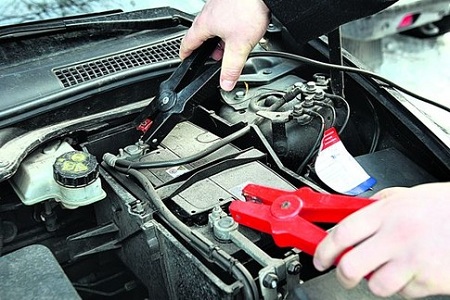
If lighting is successful, you need to warm up the engine for several minutes without pressing the gas pedal, since an increase in generator speed can lead to a voltage surge and failure of the electronics. Then you should disconnect the wires for lighting in the reverse order, first of all, disconnect the black wire from the engine. Then you need to remove the "crocodiles" from the charged battery. Before disconnecting the wires, it is advisable to turn on the heating in both machines rear window and interior fans, this will help smooth out the power surge. Do not turn on the headlights as they may burn out.
There is also the option of lighting the car while the engine of the starting car is running, however, in this case, undesirable consequences are possible. In particular, overloading of the generator or failure of the electronics cannot be ruled out.
There is another way to light a car from another battery, which can be used if there are no connecting wires at hand and if the engine is carbureted. To do this, connect a charged battery to the car, start it up and, without turning off the engine, change the charged battery to a discharged one. If the car is equipped with an injector, this method can cause problems with the electronics, for which it was nicknamed by the people “the murder of the injection car”.
After a successful start, it is advisable to make an active and long trip so that the battery can be recharged from the generator. The word "active" means a trip to a moderate high revs motor (at least two thousand per minute) on the tachometer. In this case, it is necessary to turn off all unnecessary electrical equipment.
Precautionary measures
So, we looked at how to charge the battery from another car, but it should be understood that the battery is an explosive item. In the event of an explosion, not only fragments, but also drops of sulfuric acid will fly in different directions. To avoid trouble, certain rules should be strictly observed.
First of all make sure the discharged battery has a normal liquid level and that she was not frozen. It is not difficult to determine the state of the electrolyte. To do this, you need to unscrew the plugs and look inside. In a normal state, the electrolyte is similar in consistency to water. If it's frozen, you will see ice or something that looks like jelly. In addition, battery jars with frozen electrolyte will be slightly swollen. Before touching the battery, it is advisable to wear gloves and glasses, as the sulfuric acid inside corrodes the skin, and there is hydrogen around the battery, which is explosive.
Do not light up a large-volume engine from a subcompact or. The fact is that the engine being started requires more energy than the donor. As a result, chances are good that a charged battery will run down without charging a dead battery.
During the operation make sure that the contacts of the black and red wires do not touch each other... In this case, you must always follow the order of connecting crocodiles, since hydrogen generated by a discharged battery can explode from a spark. Note! If a discharged battery is cracked, or you notice that liquid is leaking, then you cannot light the car, and the battery must be replaced.
Since lighting a car is a delicate matter, you should not entrust this operation to another driver. In any case, wrong actions can damage your car or even yourself.
That, in fact, is all the wisdom of starting the engine from an external battery. To avoid this procedure, make it a rule to always check if any power sources are turned on. This should be done even if you leave the car for a short time. Banal carelessness can cause you a lot of trouble.
Probably every car owner or driver has come across a situation when the car's starter refused to start the engine due to a dead battery. Unfortunately, such situations often happen, especially with the onset of severe frosts.
If your car battery is relatively new, most likely, it will not let you down even in cold weather, but if it is already pretty battered by life, you need to be always ready for the situation described above. First of all, do not forget about periodic maintenance of the battery. Checking the electrolyte density, adding distilled water and charging it is not such a difficult process, but it can help keep the battery in constant tone.
However, it also happens that even a new battery, not to mention old ones, can "run out" in just one night. It is worth forgetting to turn off the light, radio tape recorder, or other electrical equipment, and starting the car in the morning will already be problematic. And if there are malfunctions in the car's on-board circuit that provoke a leakage of current, the likelihood of a problem increases significantly.
In order not to become a hostage to the situation with a "dead" battery, carry with you special wires designed for just such cases. If a car with a charged battery and a conscientious driver is nearby, you can always start the engine of your car by “lighting” it from a charged battery. We will talk about this simple method in this article, where we will consider all the nuances of the process.
What is the "lighting" process
The essence of the method of emergency starting the engine from another car is to power the on-board circuit of your car from a working battery. For the convenience of perceiving information on this topic, motorists often use the medical terms "recipient" and "donor", the first of which means a car with a dead battery, and the second - a car with a charged battery.
For "lighting", as already mentioned, two special wires with crocodile clips at the ends are used. They are connected to the terminals of the "donor" working battery and the onboard circuit of the "recipient", after which the latter tries to start its engine. We will talk about how to properly connect the "cigarette lighter" a little later, but now let's figure out what it is and how to choose the right one when buying.
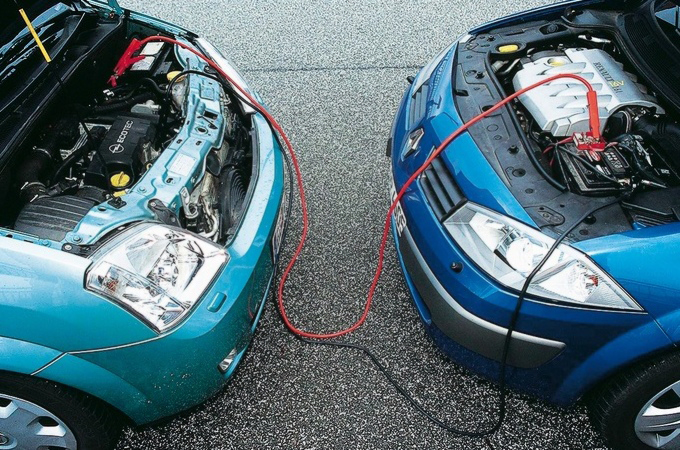
Requirements for the "cigarette lighter"
In car dealerships, in car markets, you can find wires for "lighting" different manufacturers, and at different prices. First of all, pay attention to the material of the conductor and its cross section. Let's mark right away if it is not made of copper - it is better to refuse such a purchase. Why copper? Firstly, it has the lowest resistivity (1.7 * 10 -8 Ohm * m), while for aluminum this figure is 2.8 * 10 -8 Ohm * m, and generally tired is 2 * 10 -7 Ohm * m. Consequently, the copper conductor has less voltage loss. Secondly, copper will last much longer than aluminum or steel.
And yet, about the section. A school physics course tells us that the thicker the cross-section of the conductor, the lower its resistance. This can be seen from the formula: R = ῥ * l / s, where ῥ is the resistivity of the conductor, l is its length, and s is the cross-section. In other words, the larger the cross section, the less the loss.
Pay attention to the insulation of the wires as well. It should be strong but elastic at the same time. If it is too tough and thin, it will crack in the cold in winter.
The next important evaluation criterion is the value of the rated current. If your car battery supplies 400 A of cranking current, it is desirable that the characteristics of the wires correspond to this value. Usually this indicator is indicated on the cover of the "cigarette lighter" or on the insulation of the wires.
As for the "crocodiles", there are no special requirements for them. The main thing is that their size allows them to "bite" at the battery terminal, and the spring was able to provide a reliable connection.
And, of course, the length of the wires. It depends on how close and from which side another car can approach you. It is definitely not worth saving on this.
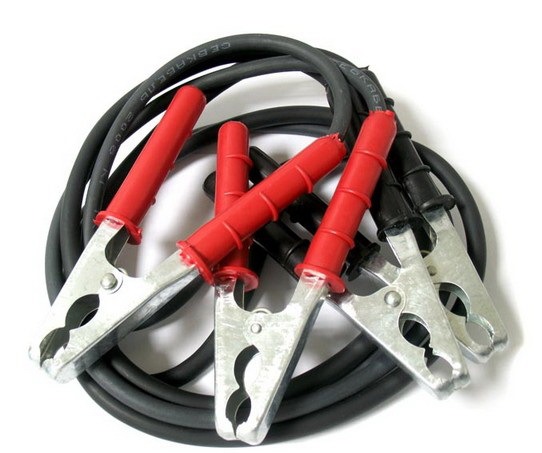
How does "lighting" begin
So, if you find that the battery of your car is "dead", and you have saving wires in the trunk, you just have to find a decent driver who would agree to help. Unfortunately, not everyone responds to such requests, but if you are lucky, ask the kind person who agreed to drive up to your car so that the distance between the engine compartments of the cars is minimal.
If you have the opportunity to choose a "donor", preference should be given to a car that is close in parameters to the characteristics of your car. As a last resort, a car with a more powerful battery will do, but in no case should you try to "smoke" with a small car if you drive an SUV. So you can plant her battery too, without achieving the desired result.
How to properly connect the "cigarette lighter"
Now we turn to the most important thing - connecting the wires. It is important not to confuse anything here, otherwise there is a risk of ditching best case several fuses, at worst - a battery and a controller, both for your car and that kind person who responded to a request for help.
There are three ways of lighting a cigarette. We will consider each of them separately.
The first way (the most secure):
- we turn off the "donor" engine;
- disconnect the wires from its battery;
- we do not remove the wires of the "recipient" from the battery;
- unwind the "lighting" wires, compare their characteristics with the characteristics of the "donor" battery;
- if everything is fine, connect the positive wire of the "cigarette lighter" to the corresponding terminals on both batteries;
- We connect the negative wire with one end to the negative terminal of the “donor” battery, the other end of the wire does not cling to the “recipient” battery terminal, but to any large (stationary) non-insulated body part removed from the battery and fuel-conducting communications. This can be the head of the bolt with which the "-" cable from the battery is attached to the body, the exhaust manifold, and other unpainted elements;
- we wait a few minutes until your battery is fed a little;
- turn on the ignition of the "recipient", try to start the engine;
- if after 3-5 attempts to start the engine it was not possible, it is better to stop the experiment, since you can "put" the battery in someone else's car, moreover, the problem with your car can be complex;
- if the launch was successful, do not rush to disconnect the terminals, let the motor warm up and the battery to recharge;
- after 5-7 minutes, the terminals can be removed in the reverse order without turning off the engine;
- do not rush to go right away, let the engine idle for at least another 10 minutes.
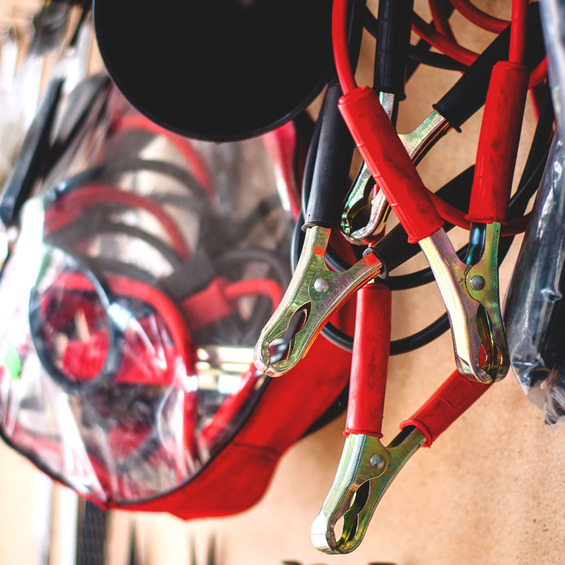
Second way (less secure but more efficient):
- after drowning the "donor" engine, remove the terminals from its battery;
- remove the negative wire from the “recipient's” battery terminal;
- with the positive wire of the "cigarette lighter" we connect the corresponding terminals of both batteries;
- the negative "cigarette lighter" wire with one end clings to the minus of the donor, and the other, attention, to the negative wire (not the terminal) of the "recipient". In this case, we exclude the "dead" battery from the circuit, i.e. the "donor" current will go straight to the starter of your car;
- when the wires are connected, we try to start our motor;
- starting the engine, again, let it warm up, and only then disconnect the "cigarette lighter";
- it is possible to connect the negative terminal to the “recipient's” battery only after the “cigarette lighter” is completely disconnected.

The third method (the most effective, but also the most dangerous):
- do not remove the terminals from the "donor" and "recipient" batteries;
- we connect the cigarette lighter to both batteries, observing the polarity;
- we start the "donor" engine and keep the speed on it in the range of 2000-2500 rpm;
- we start the engine of the "recipient".
The main danger with this method is all the same voltage surges. They pose no danger to the "donor", but in your car they pose a threat to the controller fuse and the electronic unit itself. The probability of their failure is relatively low, but it still exists.
The main mistakes made when "lighting"
No one is immune from mistakes in this process, so it would be better for you to read about other people's miscalculations than to learn from your own. Here are the most common ones.
1. Non-observance of polarity: the positive terminal of the battery of one car is connected by a "cigarette lighter" with the negative battery of another car and vice versa. The result is a short circuit, blown fuses at best;
2. Contact of the positive terminal of the battery through the "cigarette lighter" with the ground, the body of the car. The result is similar.
3. "Lighting" a car with a battery with a large starting current, from a weak battery. The result is a discharged donor battery.
4. Using a "cigarette lighter" with a low rated current from a battery with a large starting current. The result is melted insulation, sometimes with damage to the current-carrying conductor.
5. Application of a "cigarette lighter" with damaged insulation. The result is a short circuit with all the ensuing consequences.
In addition, watch a video on how to properly light a car:
There are a number of reasons why the battery can weaken significantly and ultimately fail in the next attempt to start your car's stubborn engine. And here are some of the most common of these reasons:
- You left the headlights, dimensions, music, or at least the ignition in the car on for a long time;
- you have not started the car for quite a long period;
- the battery contacts are simply dirty, the acid level has dropped critically, or its time has simply come;
- for one reason or another, your car's generator has failed, which charges the battery while the car is running;
- Very low air temperature (which can act as a catalyst, accelerating the process of "death" of the battery due to one of the above reasons.
What to do when the car won't start due to a dead battery? The answer is obvious - light it. Of course, you can also call a tow truck, ask to take you in tow to the service authorized dealer, call your auto mechanic, relatives, friends and acquaintances for help, but is it worth the candle when it is enough to perform a completely easy action - to light another car from the battery. And how to do this, let's find out in more detail!
First, you need to make sure that the problem is really with the battery. And the most obvious symptom of the problem will be a very sluggish starter at the beginning, which after several attempts will not spin at all. In addition, the starter may not even work in the first attempt to start the car, and then you need to determine that it is in the battery, and not in the starter, and you will understand this quite easily - you will feel that the starter drive is applying at least some efforts to try to budge crankshaft engine - if you can't feel it, try going out and looking under the hood, having someone turn the ignition key.
So, we have determined that the problem is, indeed, in a discharged battery. And how to properly light a planted car battery from another car? Note that you should never try to start your car if the battery is cracked and visible acid leaks.
First of all, let's define what we need to light a battery from another car:
- First of all, we need a set of wires for lighting, called "crocodiles" because of the tips of these wires in the form of pincers with teeth similar to the mouth of a crocodile - in general, every motorist should have this device in the list of must-haves along with a jack, with an emergency stop sign, a first aid kit and a fire extinguisher, so make sure to purchase a set of "crocodiles" at any car dealership. Well, if you don’t have these wires at the right time, then you can always count on other drivers who most likely have them.
- The second indispensable attribute of "lighting" a car is another car with a well-charged battery. Let us hereinafter call it "donor", and our car with a dead battery - "acceptor".
So, the process of lighting a car from another car in general cases is extremely simple and it consists of only a few stages, let's in order:

As you can see, everything is quite simple!
And a few more tips for lighting cars:
- Never light a large crossover / SUV or a powerful car from a small car battery, otherwise you will later have to look for donors for both cars. In addition, the acceptor must be a car with a good new charged battery, otherwise you will also have to light both cars.
- When choosing crocodiles in stores, buy wires of at least 14 mm 2 with a cross section and a length of at least 3-4 meters (both of these indicators should be as large as possible).
- Do not be alarmed if a spark appears when connecting the negative cable (in step # 4 above) to the acceptor car (the very last plug-in end of the wires) - this is within normal limits, but that is why it is recommended to connect it away from fuel cells.
- Never light a cigarette if the donor has visible damage to the battery, leaked electrolyte, or during operation.
You get into your car, put the key in the ignition, turn it to start it, but there is no reaction from the starter. The first reason for such a malfunction may be battery discharge.
However, there is one possibility of starting the engine of your car, if you "light" it from a charged battery of another car. Tips on how to properly light up from the battery, we will consider in today's article.
1. We drive up to the car that we are going to start. We put the car as close to the hood as possible in order to facilitate the connection of the wires for the lighting. On both vehicles we open and fix the hoods, making sure that vehicles do not touch each other. We turn off the ignition and all possible energy consumers in cars.
2. Now, first of all, connect the positive terminals. First fix the wire with the positive terminal on the discharged battery, then with the positive terminal on the charged battery. Positive terminals are usually red. Then connect one end of the other wire to the minus on the charged battery, and the other end to the ground (not the battery!) Of the car on which the discharged battery is located. If the car does not have a special dedicated such mass in the form of a special pin, select for this an unpainted part of the engine that is as far as possible from the battery, fuel lines and moving parts. Pay special attention to the fact that a spark will appear at the moment of contact!
3. The next step is to start the car engine with a charged battery. Let it work for 5-10 minutes. During this time, the second car will charge your discharged battery.
4. After this time, we start the engine of the car with a cigarette. At the moment of starting, you can slightly increase the speed on the donor and let the machines run for 2-3 minutes.
5. Finally, remove the wires in reverse order. First negative and then positive. To reduce voltage peaks when disconnecting wires, be sure to turn on the heated rear window and the blower fan on a vehicle with a discharged battery. It is impossible to turn on the headlights instead of heating the glass, since the peak voltage will cause the lamps in them to burn out.
Tips and Warnings.
If a vehicle with a discharged battery is injected with fuel electronic system control, it will be better to turn off the donor motor in order to reduce the risk of damage to electronics from power surges. However, there is a risk that the only charged battery will be completely discharged.
The thicker the lighting wires are, the better. For cars with engines of 1.5 liters, the cross-sectional area is 16 sq. mm or 4.5 mm in diameter, and the optimal diameter is 9.5 mm, which is suitable for many passenger cars... Copper is used as wire material. The insulation should be strong, but soft, so that it does not harden and crumble in the cold. The connection of the clamps to the ends of the wires must be soldered - a simple crimp is not enough for reliable contact. The crocodiles themselves should have an insulating coating and sharp teeth for better contact. The optimal length of the wires is 1.5-2 meters, because the shorter they are, the less resistance they have.
